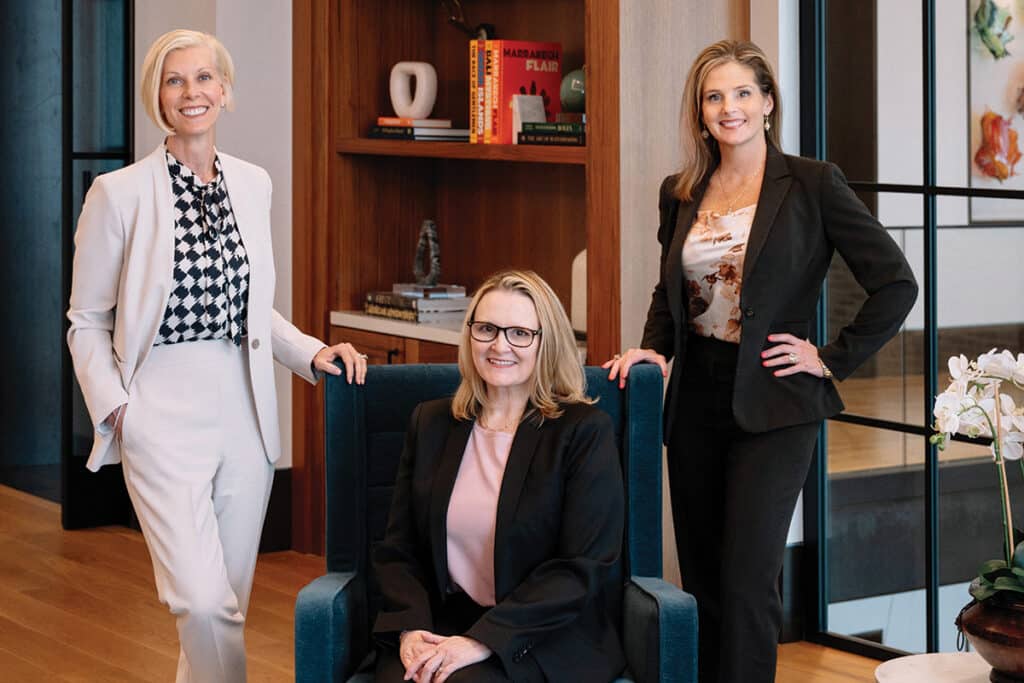It used to be that when people thought of shopping for used clothing or furniture, thrift stores and yard sales came to mind, with well-worn items available for pocket change.
That was a generation ago. As consumers, we’ve developed an increasing taste for the finer things in life — designer clothing, furniture and accessories.
For some, the markup on the price tag only adds to the allure, but for most of us, it’s more practical to find those luxuries for less.
Consignment and resale boutiques rose to meet the opportunity and have all but erased the stigma of buying “pre-owned.” Increasingly, it’s a way for savvy shoppers and fashionistas to find high quality and high style without the high price.
It’s easy to find a resale shop –- they’ve become ubiquitous in suburban strip malls — but like other types of businesses, only a fraction thrive in the long run. Here, you’ll meet several local women who found their niche in the nearly new department.
LINDA REAMS
Too Good To Be Threw Clothing and Furniture
At 27, Linda Reams was unhappy with her office job. On a trip to Houston, she saw something she’d never seen in San Antonio — a clothing consignment shop. She recalled her mother, who clothed five kids on a budget, and knew this was an idea that could work.
“I went back to San Antonio, found a location and opened Too Good to be Threw. That was pretty much it,” says Reams, who quickly outgrew her first shop at Loop 410 and Nacogdoches, as well as several other locations, before moving her clothing boutique in the 1990s to 410 and Blanco, where it remains today.
Reams started on a wing and a prayer. She didn’t have a business plan, and she didn’t have any retail experience. She became busy so quickly that she didn’t have time to take a step sideways to think about the business end of things. “It was all so exciting,” she says. “I learned about the business as I went along.”
She started small, consigning women’s clothing, and when her regular customers started asking her to add men’s and children’s items, she listened. She added a second location to sell furniture on consignment and sold it to her mother five years ago. Most recently, she opened her newest location, a partnership with her mother, selling clothing and furniture in the same shop.
Reams, who has now been in the consignment business for 26 years, has seen attitudes change and the quality of the merchandise she sells on her customers’ behalf increase. She describes many of her regular customers as shoppers who “thrive on the thrill of the hunt, always looking for that treasure.”
Early on, Reams learned to be extremely selective when choosing which items to sell, a practice that helped define Too Good To Be Threw as a high-end consignment boutique. “When people walk in, they see displays that look like new retail, and they get personalized service like you’d expect in more exclusive stores,” Reams explains.
To continually make that distinction clear and keep customers coming back, Reams says they must decline a lot of itemsoffered for consignment. “You have to have a knack for knowing what will sell. You can’t take everything,” she says. For example, Too Good To Be Threw typically does not accept anything that’s more than two years old. “There are a few exceptions; some things keep their style a bit longer. You know when you see it,” says Reams.
The work that goes into a clothing boutique is not for the weak. There is a lot of heavy lifting and reaching to high places that makes it a physical job on most days. Reams also describes it as more chaotic and unpredictable than a job in an office environment.
“There are a lot of people who think it’s cute and fun to work in a clothing boutique, but the truth is, this job isn’t for everyone,” she says. As her business grew, Reams said she learned to delegate to her employees, but running the shops is still an all-consuming endeavor for her. “I can cut it off now,” she says. “After 26 years, I can trust my employees to close the shop.”
Even so, Reams says much of her time is devoted to work: “It never ends, I’m always here. I was 27 when I started this business and I’m still unmarried.”
She still feels the weight of the responsibility on her shoulders. “When something is yours, you care the most, you try harder. It’s your reputation, and that motivates you to try your hardest,” she says.
KAY TAYLOR
Bygones Furniture
Kay Taylor thinks of herself as a teacher. And although she’s sold things to people her entire career, she doesn’t consider herself a salesperson.
At Bygones, her consignment furniture store, Taylor uses her degree in interior design and expertise as a former real estate pro to help her customers make important decisions about their home’s décor. Some are adding furniture, others need to downsize. Either way, Taylor’s keen eye for arrangements is evident.
In fact, it was furniture arranging that got Taylor into the consignment business. Before relocating to San Antonio in the early 1990s, her Fort Worth design studio provided what was at the time a novel interior design service — helping people make the most of the furnishings they already had. Quite often, clients would see that they no longer needed certain pieces.
“At the time, I had no agenda, I wasn’t selling anything,” she says. “I just wanted to help my clients sell things they no longer needed.”
Taylor went into consigning furniture with no idea how challenging the work would be, but she quickly built a successful business buying and selling used furniture in Fort Worth in the 1980s. When she sold the business, Taylor thought she’d enjoy some downtime, but she became restless. She moved to San Antonio in 1991, and in the process of furnishing her condo here, decided that she would start another furniture consignment business here. Taylor opened Bygones in 1992. “I didn’t know anyone here,” Taylor says. “I just knew that San Antonio needed a shop like the one I knew I could have.”
Bygones is proof that styles can mix and match artfully in a room. Taylor takes time to arrange furnishings daily. The idea is to create an environment that looks and feels more like someone’s home, not a showroom floor in a furniture store. “We have new pieces coming in all the time, so there’s always something new to add,” she says. Taylor is very selective about the furniture she accepts for consignment. Quality is essential, but Taylor says she prefers that her shop not be crowded, making it easier for shoppers to focus on the pieces she does display. “I don’t like to have pieces on top of each other,” she says. As a result, Taylor accepts only about 60 percent of what she’s presented with.
Selling real estate, Taylor learned the importance of keeping the buyer and seller separated from one another while she manages the sale. “Now, I’m brokering furniture instead of houses. I get a lot of repeat business. Eventually, my sellers become buyers, and my buyers become sellers,” she says.
Helping Taylor at Bygones is her daughter, Tiffany Searls, who has worked alongside her mother for eight years and is now a partner in the business. “Tiffany really has a talent for this, and I’m completely confident that she’ll run with it when I’m ready to retire,” says Taylor.
In the meantime, Taylor has no plans to stop working. In fact, she admits that it’s been weeks since she’s even taken a day off, and she hasn’t taken a vacation since opening Bygones 14 years ago. She elaborates, “When you have a shop like this, you’re married to the business. You can’t think like an employee. You have to set goals, and the numbers have to work. I don’t bring it home with me anymore though; I’ve learned to turn it off — there’s always another day.”
Until recently, Taylor was nomadic. “I’ve owned 24 homes. I always felt the urge to keep moving,” she says. She notes that her restlessness seems to have passed. “My store is in a constant state of movement. I feel grounded now. I haven’t felt the desire to move in more than six years,” she comments.
KRISTEN KRAWCZYNSKI
Kid to Kid Children’s Clothing, Toys and Equipment
When one door closed for Kristen and Ken Krawczynski, another one opened. A small pink door.
Kid to Kid, the children’s resale store the Krawczynskis opened in 1998, was their dream. They just didn’t know it until an unexpected job loss had the couple considering their options. Ken, who had always worked in retail, told his wife that he had always wanted to own a store. In their research, they found Kid to Kid, a national resale chain offering a franchise opportunity in San Antonio.
The shop is memorable to its young customers, in part because the storefront features a kid-sized, bright pink door. Once inside, Kid to Kid has the look and feel of a traditional “new” children’s boutique, which is exactly what Krawczynski wanted.
“I didn’t like the idea of a resale shop. The ones I had been in smelled funny, and they had toys and clothing in poor condition,” she says. She wanted to give her husband a shot at his dream, though, so they visited locations in other markets. “I was blown away,” she says. “Right then, I knew we could do this.”
Kid to Kid offers cash or in-store credit in exchange for new or used children’s clothing, toys and equipment. The chain has about 50 locations nationwide, and the Krawczynskis’ store is a consistent top performer for the chain, selling about 7,000 items per month. Many items come to them as the result of closet-clearing projects, but they also offer a few new items, mostly accessories and inventory acquired from selected vendors or retailers going out of business.
Resale and consignment stores are alike in the fact that they must have a virtual crystal ball to project future demand for their inventory. Retail stores selling “new” merchandise have sophisticated sales projections and automated inventories handed to them, so that the right items in the appropriate quantities are ready to go on the sales floor, where they are sold quickly, making way for the next, predictable set of arrivals.
“We don’t have that — we just have to know what will sell. We have to be choosy; we can’t take everything that comes in, and sometimes it’s hard to tell customers we can’t take their things,” saysKrawczynski. “This business is getting more competitive, so we have to work hard to get and sell the best merchandise.”
Like any other small-business owners, the Krawczynskis admit that the store requires a lot of time and attention, but they have found balance in relying on each other’s strengths to make the business run. While they both handle all of the tasks at= one point or another, Krawczynski is comfortable with many of the behind the scenes tasks, like staffing, bookkeeping and inventory, while her husband is more often the “front man,” playing to his outgoing personality by doing much of the store’s marketing and customer relations.
The Krawczynskis’ two children, who were toddlers when Kid to Kid opened, are now 10 and 12 years old, and enjoy helping out in the store. “That’s part of having a family business,” she says. Owning their store has also given the family the flexibility for Krawczynski to take a more direct role in educating their children, who are now homeschooled.
“I enjoy working with my husband, says Krawczynski. “So many women have a husband who leaves for work at 8 and comes home at 5, and that’s all they know about his day.” Krawczynski admits that while they enjoy their success, the challenges never leave the forefront. “Anyone wanting to do this has to be ready for a huge sacrifice,” she says, likening it to parenthood. “Parents don’t leave their kids unless it’s with someone they trust. The store is the same way. How will our employees treat our customers if we’re gone for a day or two? We have to look ahead for opportunities to break away.”
NELDA CARDENAS
Nelda’s Vintage Clothing Vintage Clothing and Accessories
Celebrities have made retro fashion the hottest look on the red carpet. Nelda Cardenas knew she was on to something years ahead of all of them.
After a career working for some venerable San Antonio stores — Joske’s and Frost Bros. — Cardenas wanted a career where she had more control over the outcome. She opened her shop in 1983, starting small, with a few thousand dollars. “I didn’t want to borrow money. I started with what I could afford, knowing that I would succeed,” she says. Every year, Cardenas was more successful than the year before, but she chose to reinvest that money into the business. “It was years before I had employees,” she recalls.
Cardenas started selling vintage furniture and accessories, but her customers kept asking her about clothing. She started with a few items, then a rack, then two racks. Eventually, the furniture was phased out, and Cardenas was in the vintage clothing business.
Nelda’s Vintage Clothing, with its fabulously funky feel, sells clothing mostly from the last half of the 20th century. The demand right now, she says, is for the retro 1980s look, with its oversized puffy sleeves, asymmetrical lines and balloon skirts.
Her employees are typically collegeaged women who have a sense of what’s popular with the young and trendy, but that doesn’t mean that Cardenas caters to such a narrow slice. Rather, her customers are as timeless as the fashions themselves. High schoolers come in for the inexpensive finds. Professional women want trendy pieces to add a current feel to their more conservative work wardrobe. Others come looking for a one-of-a-kind accessory, a dress for a formal occasion or an over-theto look for a theme party.
“Our customers can come in here and find something that’s authentic, not a mass-produced reproduction,” says Cardenas. “When you pair the right vintage piece with more modern clothing, the result is current without looking like you tried too hard.”
The store has found another way to reach an even larger audience — online. Cardenas says she’s surprised at the success of neldasvintageclothing.com, and even though she says it’s like running a business within a business, she wonders a little why she didn’t start her Web business sooner.
Determining her own success motivates Cardenas. “I set my own course, but it’s hard,” she says. “You need to make sure it’s something you love and that you have realistic goals, because you’ll give up a lot — so much of your time is dedicated to your business. You need time and energy to succeed. When things are slow, it’s up to you to change things.”
JO LYNN SWINT
Off My Rocker Furniture
When Jo Lynn Swint was a girl, she loved scavenger hunts. “I was the one who knocked on every door t find the items on my list — I’d always win,” she remembers.
Swint still feels the thrill of the hunt every day at Off My Rocker, her furniture consignment store. The shop is a mix of upholstered furniture and accent pieces, such as lamps, cabinets, chairs and architectural salvage.
It took her a while to answer the call. Spending much of her adult life doing predictable things — marriage, family, a traditional corporate job — by the mid-1990s, Swint was single again, and her kids were grown. The only thing left to do was quit her office job, which she did, in 1996. The next thing she knew, she was buying a truck with a trailer and setting up a stall in a co-op market to sell a jumble of furniture and other items on weekends. When Swint wasn’t doing that, she was on the road, buying and selling pieces in far-flung places. She was living her dream, and she was supremely happy.
Her happiness was dashed for a time. A short-lived business partnership failed, draining her emotionally and financially. “I was 51 years old. I went home and I cried. I didn’t know what I was going to do,” she says. Her two sons helped her steel herself and start over: “On a Sunday afternoon, I grabbed a Coke and a bag of peanuts and drove around, looking for a place for my next shop. I drove into Olmos Park and peeked into a window with a For Lease sign, and I knew this was it.”
The building’s owner wasn’t so sure. He told her that an antique shop wouldn’t work in that location. She assured him she was doing something different.
Four years later, Swint is still doing “something different” in that location, and success has her on Cloud Nine. “Olmos Park is like a small town. I came here not knowing anybody. I was terrified; I didn’t know what to expect,” she says. As if it were a Main Street storefront, passers-by peer into Swint’s windows, and visitors to her store are neighborly. “People bring me food,” she laughs.
She works with decorators, dealers, estate liquidators and people coming in off the street to buy and sell pieces that might have outlived a life in one place, but can be a perfect addition in the home of the next owner.
Like other resale or consignment shop owners, Swint can’t accept everything that’s brought in, but she doe accept some things that other shops might not. “People bring in sentimental things, and sometimes I just can’t pass them up. A lot of consignment stores won’t take the little things, like grandma’s teacup and saucer, but I do,” she says.
It’s that nostalgia that gets Swint a little misty-eyed sometimes, even if her customers are untouched. She got a call from a woman who wanted to sell her the contents of a storage room she could no longer afford to keep. Swint surveyed the lot, but was touched by one thing in particular. “There was a photograph of the woman’s grandfather, right before he went off to war,” she says. The photo was in a cedar keepsake box, along with the clothing he was wearing in the photo. “I couldn’t believe she didn’t want to keep this memory, but it’s easier for some people to let go, I guess,” Swint says.
Swint says the popularity of home improvement shows has been a real shot in the arm for resale shops, flea markets and yard sales. She’s been in the right place at the right time to satisfy the thrill of the hunt for people, like her, who never lost the passion for the scavenger hunt.
“I just got a set of flatware from the Waldorf-Astoria in New York,” she says breathlessly. “You won’t find that in any big-box retail store.” Though her shop is more like a boutique, her approach to buying and selling still has an air of the market. “I have a sale every day,” she says. “If a piece came in today, I’d knock it off if someone wants to bargain.”
Swint concedes that her business takes just about everything she has to give, but she adds that shouldn’t be a problem if you’re giving everything to your passion. In return, she says she’s found the confidence and satisfaction she had been searching for. “I would have started this business 20 years ago, but I didn’t have a clue what to do. I never had a business before. I didn’t know about programs that help women start businesses. I didn’t know that I had to apply for a business name at the courthouse. I started this with a little bit of nothing. It’s my life — it has its drawbacks, but it’s the greatest thing I’ve ever done,” she confides.
BARBARA ALLISON
Encore Clothing
Barbara Allison was a military wife and stay-at-home mom with five kids, all born one year apart. When her family had to attend a special occasion, she knew it would be crazy to buy new jackets for her boys, because they’d only wear them that one time. So the resourceful mother went to a used clothing store, where she found just what she needed, at a fraction of what she would have spent in a department store.
Allison continued raising her kids, but when they started leaving home, she began looking for work outside of the home. She liked furniture and was good at interior design, so she opened two franchise locations for home décor retailer Bombay Company. “San Antonio wasn’t ready for 18th-century reproductions,” she says. The parent company decided to close her stores, and Allison was at a crossroads. She remembered her experience buying used clothing for her kids, and decided that she’d open a consignment store.
Encore has specialized in name brand and designer women’s clothing on consignment since Allison opened the shop in 1985. She quickly admits that she is not a clothes hound, but she knew one thing for certain: “My goal was to be a cut above and to know my target customer from day one,” she says.
Allison’s customer is a woman who wants a high-end wardrobe, and who doesn’t want the cookie-cutter look found in traditional retail stores. She buys clothing from people across the country, resulting in a diverse inventory that is not likely to have a look-alike, at least not in San Antonio.
Allison says that with relaxed dress codes at work, fewer women are looking for traditional business clothes these days, meaning her customers could be coming in looking for just about anything, from a special occasion dress to more casual clothing.
Allison made a practice of hiring women with an eye for fashion and a penchant for service. Treating customers like valued insiders is part of her strategy. “We help customers refine their personal style. If something doesn’t look quite right, we’ll say so. That way, when we say something looks fabulous, our customers can believe it,” she explains.
Allison also keeps a customer call list, with style preferences, size information and other details. When items come in that match what a customer is looking for, Allison or one of her employees makes the call. “All the customer has to do is come in, see the ensembles we’ve set out, make her selections, and she’s out the door. There’s no fussing over finding the right size, and wondering if the style is going to work, because we already know that,” she says.
She also knows that a newcomer to her shop is an opportunity to gain a long term customer. “The customer I want is the one who comes in and sees a lot of things she likes, even if she doesn’t find anything in her size that day. She’ll be back, because she knows that the next time she comes in could be the time she finds exactly what she’s looking for. Then she’s a customer for life,” says Allison.
When Allison travels, she finds herself investigating stores in other cities. “I’m always curious to see what other stores are doing,” she confesses. “I look at their merchandise, their displays and I want to see how they treat their customers,” she says. This competitive analysis gives Allison new ideas to refine her own business. “For people who frequent consignment shops, the attraction is as much in finding something unique as it is the lower price,” she says. “I want to make sure that’s what we’re delivering.”
Author: Susan Sheffloe Speer
Photographer: Janet Rogers




